Announcement: YOUTH+ decided for their EUROPARC Youth Representative 2018-2020
During the last week the young people active in the EUROPARC Youth+ programme stated their opinion in a mail consultation process. Now it is official: Congratulations to Laura Peters – the old and new EUROPARC Youth Representative!
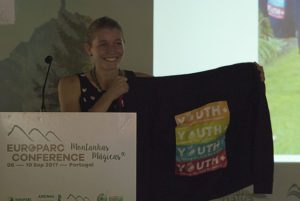
Laura Peters at the EUROPARC Conference 2017, Magic Mountains, Portugal
The election process took the form of a mail consultation, where the young people involved in the main Youth+ programme actions of the last 5 years were asked to express their support, disagreement or abstention in regard to Laura Peters (23) being re-elected as Youth Representative (YR).
Read into Laura’s full application and watch her personal video message here. To get an overview of the requirements for the role of a EUROPARC YR check out this article. For some background on some of the main milestones in the Youth+ programme mentioned check out: EUROPARC Youth Conference 2013 Declaration, the Youth+ Camp 2015 Aigüstortes Declaration, the Youth Conference 2017 Presentation.
We are glad to announce there was only supportive feedback on Laura Peter’s candidature and understand the feedback of the Youth+ demonstrates that they are ready to keep working the way they have started together. Informed about the outcome Laura states
I am very happy to have another two years as the Youth+ representative and am looking forward to working together with all the Youth+, the Youth+ Council and the EUROPARC Council in this period. See you all at the Conference in Scotland!
Expressing their votes, supporting the role of the YR, the young people active within the Youth+ network are making it clear: they want their voice heard directly in the EUROPARC Council. The EUROPARC Federation in turn very much appreciates their dedicated commitment and energy, the new ideas and dynamic approaches the youth brings into our network!
The EUROPARC Federation is looking forward to another 2 years of great teamwork and good progress on our activities with the youth from Protected Areas across Europe! Keep up the good work everyone – we’re glad to know you all on board and are excited to keep advancing our youth activities with you. 🙂
Elections for a EUROPARC Youth Representative 2018 – Applications closed!
Youth+ Jumpers just hanging around - a rare moment. Photo by Laura Peters
____________________________________________________________________________
EUROPARC believes that the young people active in parks across Europe are not only the potential future managers of our Protected Areas. They are also their valuable advisors, ambassadors and innovators, whose voices need to be heard. As future stewards and managers of our natural and cultural heritage, young people’s contributions must be recognised as crucial for the administration and management of Protected Areas already today.
____________________________________________________________________________
Who will be the new Representative of Young People from Europe’s Protected Areas?
With the first elected EUROPARC Youth Representative Laura Peters (mandate 2016 – 2018), the Federation had welcomed a committed new face to its Council, whose fresh ideas and hard work have driven the development of the EUROPARC Youth+ programme over the past two years.

Laura Peters at the EUROPARC Conference 2017, Magic Mountains, Portugal
The EUROPARC Federation appreciates and thanks her for her commitment – and for the courage to pioneer the position of the Youth Representative. In 2018 Laura Peter’s mandate ends and EUROPARC has now just closed the application period for the next mandate 2018 – 2020.
Read more about the elections in 2016 and the still valid requirements for candidature here.
Quick overview: Role & Tasks of the Youth Representative
- Assist and advise the Council on how to oversee the work of the EUROPARC Federation;
- Bring extra insight to Council: a youth perspective to identify and solve problems arising from the changing agenda for biodiversity and sustainable development in Protected Areas;
- Work with the Directorate, as necessary to provide regular reports to the Council on the development of the Youth + programme;
- Represent the EUROPARC Federation, where appropriate – in dialogue and exchange with youth organisations and networks at the European level;
- Assist EUROPARC to increase the involvement of young people its decision-making and in the work of Protected Areas;
- Share information and provide feedbacks to youth in Protected Areas across Europe;
- The Youth representative should attend at least 2 council face to face meetings per year.
The EUROPARC Directorate and Council will provide induction information and a mentor to support the youth representative in the course of its mandate. EUROPARC will cover travel and accommodation costs for the participation to relevant meetings and events.
Canditature 2018-2020: Who is running for the position?
Within her first two years as EUROPARC Youth Representative Laura Peters has earned the trust of her peers, established the Youth+ Council and grew some profound experience of what it means and takes to work with the Federation Council. Seeds were planted and it might come as no surprise, that Laura is now running for a second period “in office” to help grow those seeds. Or as Laura put it in her own words in her application:
My first year was about learning, my second year was about preparing and now I hope to get chosen again for the next two years to execute plans and ideas!
Check out Laura’s full letter of motivation
and watch her short video message below, where she tells you about her activities and experience during the last 2 years and explains her motivation to stay “in office” as the EUROPARC Youth Representative for another 2 years.
Election procedure 2018 – 2020
Besides the application of Laura Peters, no other applications were received and therefore the election process will run as follows:
All participants of the Youth Conference 2013, the Youth+ Camp 2015 and the Youth Council will be invited by mail to express their support for Laura Peters before the 16th July 2018.
Also disagreement and abstentions will be collected. The results of the consultation will then be considered and announced by Friday 20th July. Make sure you follow our news!
Eventually, the elected Youth Representative will be invited to attend the EUROPARC Council Meeting in the Cairngorms National Park – UK, during EUROPARC Conference 2018.
The outcomes of the TransParcNet Meeting 2018 in Podyjí (CZ) and Thayatal (AT)
TransParcNet Meeting 2018 © Silke Weich
10th TransParcNet Meeting
From 5th to 8th June, 70 participants from 14 countries attended the TransParcNet meeting 2018,organised and hosted by Podyjí National Park (Czech Republic) and Thayatal National Park (Austria), supported by Interreg Austria – Czech Republic.
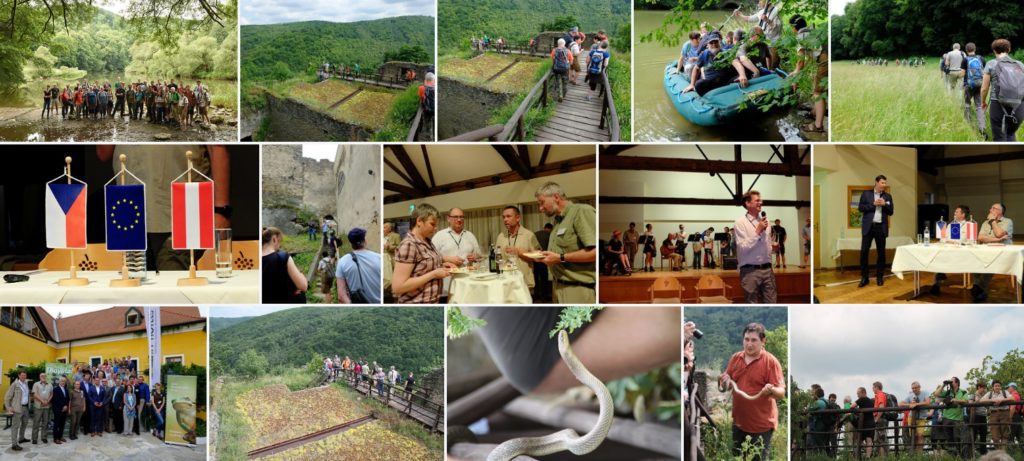
See the photo album at: http://bit.ly/transparcnet2018
“Bridges over troubled water – Nature protection of river landscapes”
The theme of this year was strictly connected with the story of these cross-border territories: situated along the Iron Curtain, they started to cooperate during the Cold War to protect the river Thaya (Dyje) against dam building. Since this dark period, the two areas continue working together with many common initiatives and projects for nature protection and public awareness.
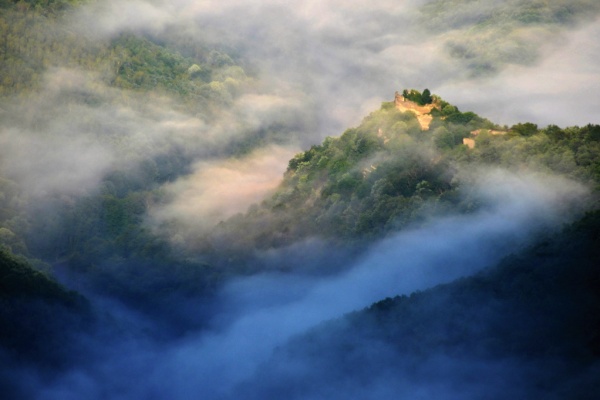
The meeting “BRIDGES OVER TROUBLED WATER – NATURE PROTECTION OF RIVER LANDSCAPES” took place in Podyjí and Thayatal area at the Czech – Austrian border and focused on nature protection of river landscapes in transboundary regions © Nový Hrádek
The presence at the meeting of Austrian and Czech high national and local authorities demonstrated the strong support that both parks receive from their ministries and municipalities: the political endorsement is indeed very important for the sustainability at long term of all transborder cooperations.
Different experiences, projects and scientific researches were illustrated in the 3 sessions devoted to the management of river ecosystems and river basins and the efforts on cross-border cooperation for water protection. Below you can download the presentations from each session.
Session I “Changes and challenges of river ecosystems”
Jan Dušek: Changes in Dyje river community and water regime during last 100 years
Robert Konecny, David Veselý: Dyje 2020 – Thaya 2020 Project (Konecny)
Robert Konecny, David Veselý: Dyje 2020 – Thaya 2020 Project (Veselý)
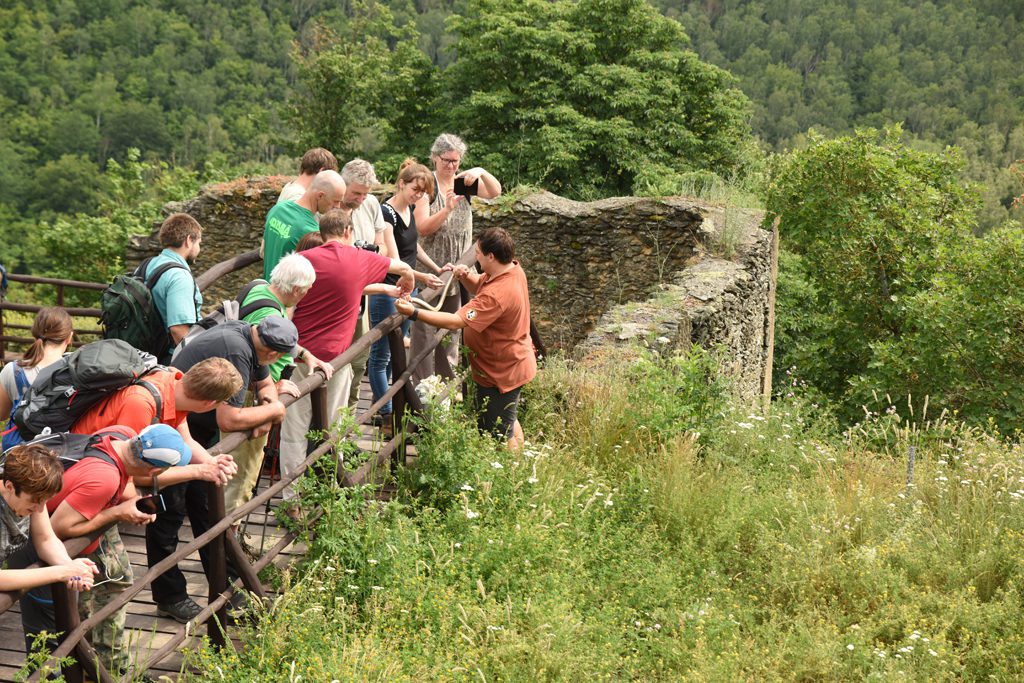
TransParcNet Meeting 2018 © David Freudl
Session II “The river basin landscape impact on the state of watercourses“
Jan Pokorný: The relationship of landscape structure on energy and water balance
Lenka Reiterová: Changes of landscape structure in buffer zone of Podyjí National Park during last 15 years
Ronald Pöppl: Soil and Water Conservation Measures in the Fugnitz Catchment
Burkhard Beudert: Bark beetle outbreak and windthrow compensate for climate change effects on water cycle in headwater catchments of the Bohemian Forest
Patrick Holzapfel: Sediments, ecosystem services and interactions of floods and droughts in the AT-CZ border region
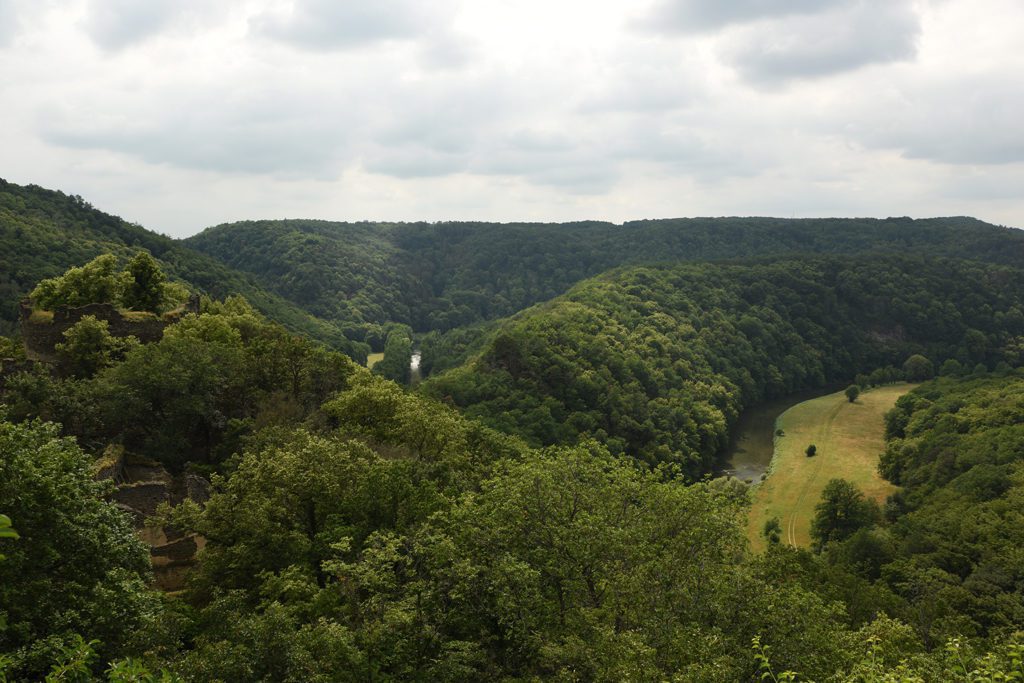
TransParcNet Meeting 2018, River Thaya (Dyje) © David Freudl
Session III “Transboundary cooperation in water protection”
Nick Huismann, Vlado Vančura: EU The WildRiver Concept
Magdalena Wagner: Amazon of Europe (Mura – Drava – Danube)
Tiia Kalske, Riina Tervo: Transboundary water management in the joint border area of Finland, Norway and Russia
Carl Manzano: Danubeparks – Transboundary cooperation and communication on river revitalization
Mihály Tóth: Wetland Connectivity project – the Raab river
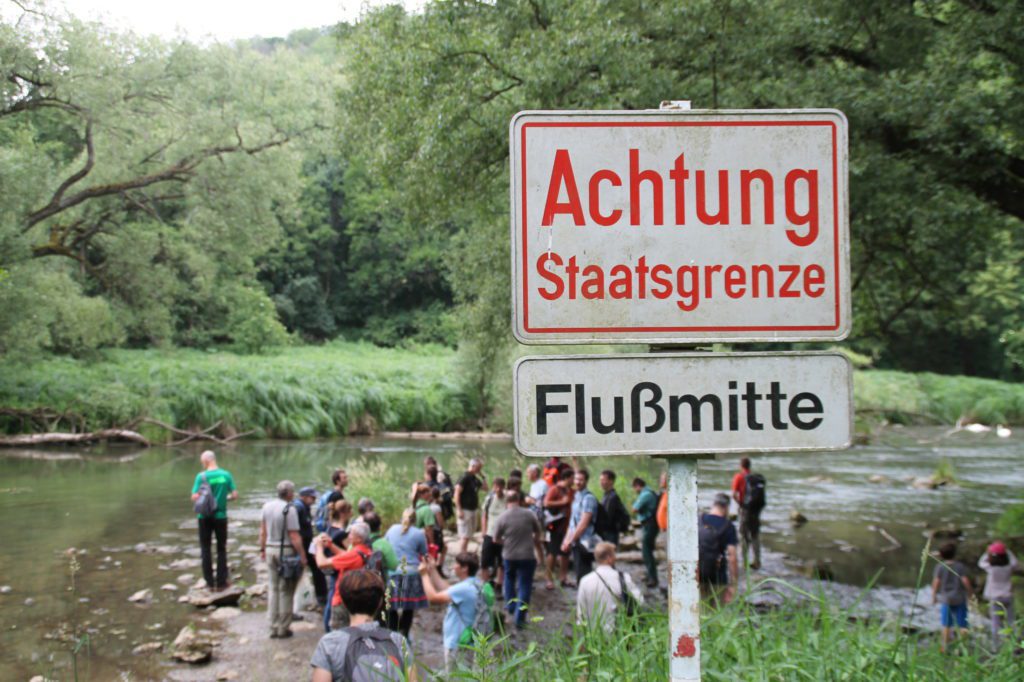
TransParcNet Meeting 2018 © Silke Weich
Final session
Christian Übl, Tomáš Rothröckl: Bridges to neighbors – project of new pedestrian bridges across the Thaya river
Michal Hošek: Conclusions
Workshop outcomes
3 workshops explored different technical aspects of the protection of rivers and landscapes and a 4th workshop focused on agriculture and climate change adaption.
In the 1st workshop “Nature protection of river habitats used for energy production”, the main pressures represented by hydropower were discussed (residual flow in small streams, non-respecting of permissions, migration barriers, influence of the water level in lakes etc.). These infrastructures could be accepted in protected areas only if they are taking into account methodologies prepared by nature conservation institutions (including rivers connectivity issues) and adopting the new (fish-friendly) technologies. The instruments from the Water Framework Directive should be more used.
Download presentation: Nature protection of river habitats used for energy production
In the 2nd workshop “Nature protection of river habitats used for water sports and recreation”, participants underlined as boating, rafting, canoeing, angling can have a very negative impact (disturbing water fauna, spread of alien species, etc.), as well as organizing water sports competitions on wild rivers.
Some suggested responses: harmonize legislation and enhance the efficiency of water management in transboundary parks across Europe, using all existing legislation options for decreasing of human impacts – incl. Natura 2000 regulation-, declare most valuable parts of river as a natural heritage without any sports and recreation. EUROPARC informed about the dialogue started by the federation with Outdoor Sport ENOS on this topic.
Download presentation: Nature protection of river habitats used for water sports and recreation (incl. angling)
The very difficult aspect discussed in the 3rd workshop was the “Harmonization of different legal frameworks in the border rivers´ nature protection”. Participants underlined the importance of establishing a good and trustful relationship between countries and the acting persons, of promoting bilateral project funding and of identifying good practice examples.
Download presentation: Harmonization of different legal frameworks in the border rivers´ nature protection
A 4th workshop was dedicated to a different topic “Agricultural landscape and adaptation to climate change” and inevitably participants asked for a change of the subsidies system in CAP (Common Agricultural Policy in the EU), and funding for farming that adopts good practices. They also stressed that in the communication to farmers it is important to emphasize that agricultural adaption is about rural development and not only about nature conservation. EUROPARC presented the federation’s policy paper on sustainable agriculture in protected areas and CAP reform and the work of the EUROPARC Commission on Agriculture and PAs in the identification of an instrument (as a new Charter for Sustainable Agriculture in PAs) to support and award the dialogue between parks and farmers.
Download presentation: Agricultural landscape and adaptation to climate change
The EUROPARC Transboundary Task Force
During the TransParcNet meeting, the new “refreshed” EUROPARC Transboundary Task Force, chaired by Michael Hosek, EUROPARC Council member, and coordinated by Stefania Petrosillo, EUROPARC policy officer and person in charge of the programme, discussed the new Strategy and identifying its priorities for the next months: among them, to increase the visibility of the EUROPARC Transboundary Programme “Following Natures Design” among other cross-border protected areas potentially interested to join the network.
The TransParcNet meeting 2018 ended with a beautiful excursion that let participants enjoying views of deep Dyje/Thaya river valley, large forests, vast heathlands and historical monuments.
A message from the Thayatal and Podyjí Directors
“We would hereby like to thank you all for coming to the Austrian-Czech border region and for participating and the TransParcNet Meeting 2018. We are especially grateful for you interest, for you support and for your willingness to share your experiences and to exchange knowledge with all of us. It has been a pleasure to welcome you in the National Parks Podyjí – Thayatal and we hope you enjoyed the meeting as much as we did. We appreciate all your contributions and would like to emphasize our thanks for your active participation which made this meeting very informative and valuable. We wish you all the best for your transboundary work and we hope to meet again soon. “
Christian Übl, Thayatal National Park director
Tomáš Rothröckl, Podyjí National Park director
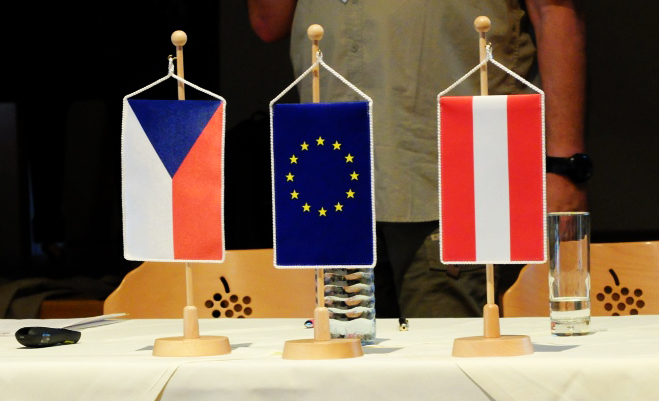 And, indeed, EUROPARC and all participants thank a lot the two directors and their enthusiastic and professional staff for the perfect organisation of this meeting.
And, indeed, EUROPARC and all participants thank a lot the two directors and their enthusiastic and professional staff for the perfect organisation of this meeting.
The use of Drones for nature conservation
Over the past years, there has been an intense development of Unmanned Aircraft Systems (or Drones). While in some aspects they can be seen as a potential threat (in terms of sound pollution, potential collision with fauna, and source of disturbance) if handled properly, they can be a useful tool to monitor fauna, habitats and marine environments. Teresa Pastor, EUROPARC project manager, attended a meeting in Spain about the potential use of drones for nature conservation purposes. Here are some of the main outcomes and examples that were highlighted in the meeting.
Some applications in Protected Areas
to monitor HABITATS
- Multispectral images uses to monitor land use and vegetation changes
- Mapping of plants (e.g. invasive plants)
- Monitoring of burnt areas => estimate BAI – Burnt Areas Index
- Plants’ vigour => NDVI – Normalized Difference Vegetation Index => assess the content of live green vegetation. It indicates the state of leaves, chlorophyll activity, and hydric stress.
- BioCarbon Engineering : planting solutions for large-scale ecosystem restoration projects
- Dronehopper – Firefighter drone designed to provide aerial support for wildfires firefighting. This is a high tech solution that permits its adaptability to different conditions, including night operations, required any moment to control wildfires. Each drone has a maximum capacity of loading up to 300 liters of water.
- Phytosanitary controls (articulated arm coupled to drone) (e.g. control Pine processionary moth)
monitor FAUNA and control disease spread
- Monitor the abundance of nesting birds in colonial species
- Monitor disease spread (e.g. tuberculosis in ungulates). The idea is to look for a spreading pattern in order to focus on treatment.
- Detection of poaching
- Disease control vector (e.g Drones that scatter swarms of sterile mosquitoes over wide areas; Zika control)
to monitor MARINE areas
- Census of fauna – Whales , Sea turtles eBee platform (mapping drone)
- State of nutrition of whales by measuring the quantity of blubber with a thermal camera sensor
- Drones which collect drops of mucus from the whales blows that are afterwards analysed in the lab
- Underwater drones – regular inspections of underwater
- Oil spill detection – https://www.maritime-executive.com/article/tests-for-oil-spill-response-drones-underway#gs.kxvieH8
SAFETY
- Life Seeker – Locates missing people using their mobile phones as beacons.
Main types of drones
– – With fix-wings: in a short lapse of time, they can travel a long distance at a high speed. They are very much employed in open spaces and agricultural fields to watch out crops
– With rotary-wings: are best used in forests, which are more inaccessible
– Hybrids with fix and rotary wings – very expensive
– Amphibious drones – Travel underwater and in the air
Moreover, drones are coupled with different types of sensors, among which:
– GPS – GLONASS (Russian satellite navigation system)
– RGB camera
– IR camera
– Multispectral imaging cameras
– Thermal vision cameras
– MicroRadars
– LIDAR – pulses of laser
– Photogrammetry